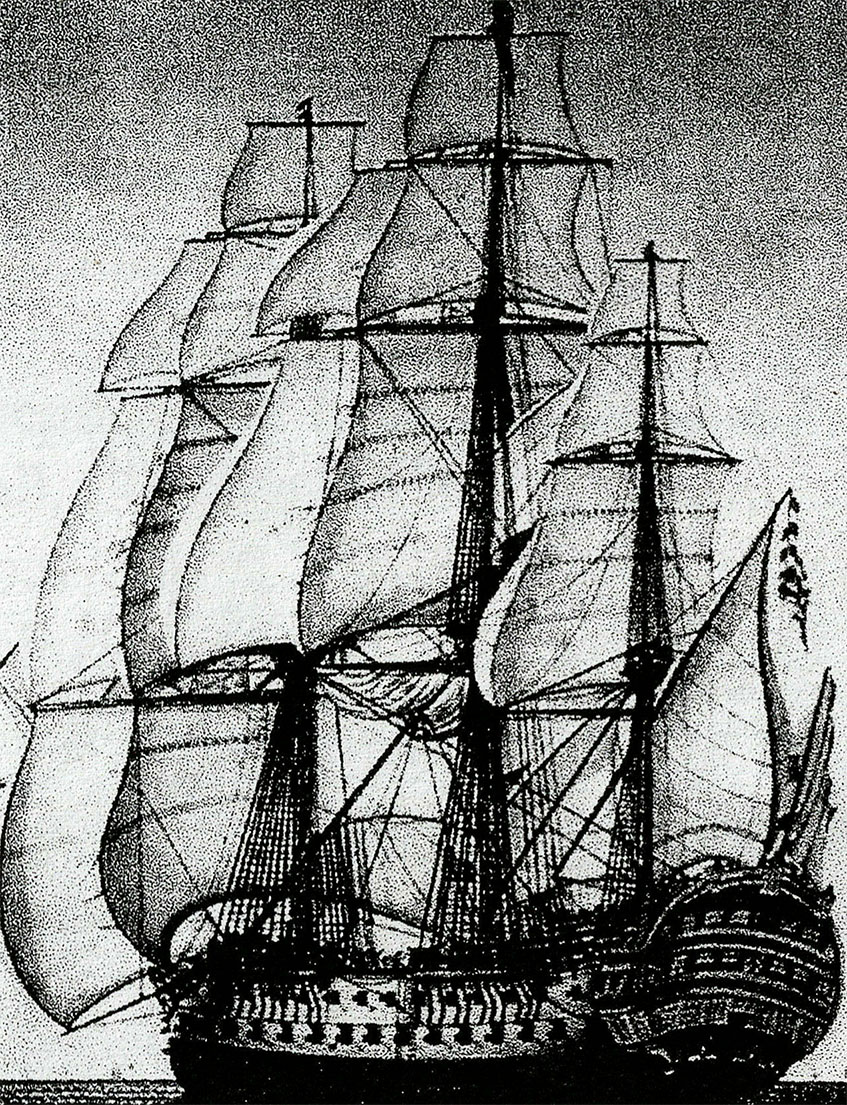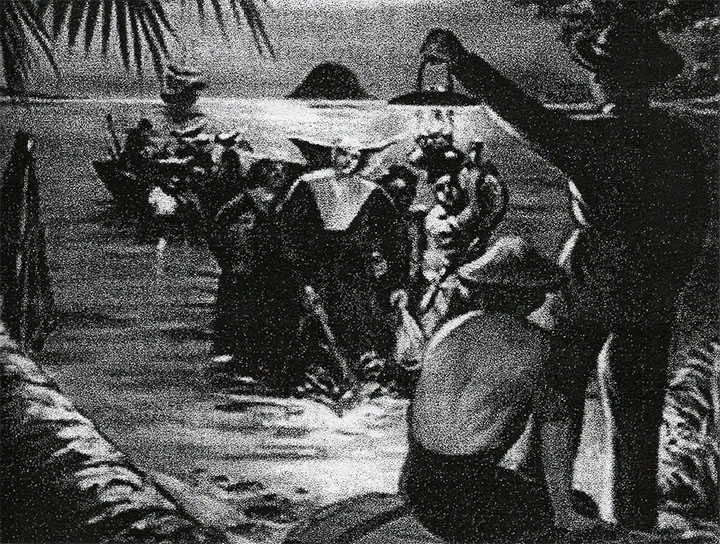Pasacao was the slumbering “visita” and served as the only existing port of the Bicol Region. The Spaniards who set foot in Bicol late in 16th century noted the importance of the visita in their exploration. Pasacao became a strategic defense port against the raids by Moro pirates from 1585 to 19th century. Due to frequent raids the town had an estimated population of only 200 in 1823.
Vessels carrying goods and passengers made their starts or stop over here. Notwithstanding the rough road to Pamplona, this town has been contributing to, a large degree, in the economic development of the province of the Camarines Sur in particular.
Pasacao’s Strategic location along the rugged coast of the vast expanse of the Ragay Gulf in the east made it very important to the economic and social life of the people of the region. It is for the reason that a parish was established dedicated to the Saint Rose of Lima as the patroness. Annually in the honor of the town patroness, a fiesta is celebrated on August 30. It is said that the geography of Pasacao makes its history full of hardships, troubles and affliction that influenced the customs, traditions and way of life of the inhabitants. The continued Moro piracy likes that one in 4 October 1779 at Caranan. The report of Bishop Manuel dela Concepcion described this raids in his letter to the king on June 29, 1758 as “undoubtedly greater at any other time.” The raids according to Domingo Abella-Bikol Annals, “ten towns and two mission were completely destroyed; ten churches were looted and burned; about 8,000 indios were captured or killed; one priest was killed, two captured, and the capital Caceres, was under alert one night. Alcalde Jacinto Rodriguez Morales provided material for a baluarte (earthwork or fortified rampant) as defense of Pasacao against these raids. He also issued rations to bantayes (watchmen, sentinels).
The port of Pasacao is rich in stories on how it got its present name. Since the part is a bustling area, dock guards were stationed to maintain peace and order. These guards would usually shout “Pasa ikaw, Pasa ikaw” as instructions to passengers. This Spanish-Tagalog mixed up “pasa-ikaw” was mistaken by the passengers as the name of the place – Pasacao.
Another story went around that fisherman who was asked by a Spanish sentry what were the contents of his basket. The fisherman answered “pasa-pasa”, the name of the fish, and simultaneously offered some by saying “ikaw” meaning to say if he wanted some. The sentry on the other hand interpreted the words “Pasa-pasa ikaw” as the name of the place. For long, the place was known among the soldiers as Pasa-pasa ikaw until it shortened to a more convenient Pasacao.
The town’s name was also said to have been derived from “Pasok kayo”. This came from a native as an answer to a Spanish soldier’s query of the name of the place. Misunderstanding clouded the native’s remark when he meant to say that the soldier come up or come in.
In a similar story as the first story, Pasacao came from “Pasa ikaw”. Some Spanish settlers while walking along the shore met a native. The settlers asked the native to pass on by saying “Pasa”. The native, on the other hand, wanted the Spaniards to go first by saying “ikaw”. Through a convenient usage, it became Pasacao. Still another story gives credence to the word “Pasangkay” as the origin of the town’s name. The travelers and traders often used it en route to Manila to ask owners of the sailboats along the shore of the village to let them ride. Pasangkay means the request of the people to get into the boat to travel. From the above-mentioned short atories, the name of the town Pasacao must have been derived from them. The Fil-American or Spanish law recognizing the legal existence of Pasacao believes. Church records however say that the founding of the church was 1885.
Very few people of Pasacao except the old during the governorship of Juan de Silva (1609–1626) two galleons (Manila-Acapulco trade) were constructed in the astillero at the Lupaon (or Dalupaon nowadays) Pasacao. They were Nuestra Señora de Guadalupe and the Angel dele Guardia. According to our Bikol historian Jose Calleja Reyes, the galleon “Guadalupe” figured both in the galleon trade between Manila and Acapulco and in the defense of the Philippines against Dutch incursion in the naval battle of Playa Honda.

A Spanish Galleon. The bario of Dalupaon was once an important site for galleon construction in the early 17th century.
Other important historical events that unfolded the Pasacao still left them landmark. The Pasacao Pier was the dockyard of the Japanese ships when it was bombed. Until now some of the Japanese ships can be seen under clear waters. The first place where the American landed is the Magtabid Beach in Pasacao. American air transportation first landed in Tinalmud with their Grasshoppers in 1945. The Pasacao seashore was the place where the Six Daughters of Charity (nuns) landed from Spain to establish the first normal school for girls which is now the Collegio de Santa Isabel in Naga City. These and many other events took place in this town.
During the early American school administrators used this port as their landing. When going to manila they had to sail from here. With no roads from Naga City they used to be carried in the hammock by hired men traversing the mountain trails. In spite of the importance of Pasacao-Pamplona road the authorities have been slow improving it. It took three days on foot from Pasacao to Naga back and forth during the late 19th century.
Today, Pasacao has become a fast-growing community. The coconut oil factory was established, the fishery school opened, oil warehouses constructed and more and more people avail of its fine beaches especially during summer time. The cementing of the Pamplona-Pasacao road has made travel a matter of twenty-minutes instead of the three-day trek in the past.

The arrival of Daughter of Charity in the harbor of Pasacao on April 6, 1867, paved the way for the establishment not only of a primary and secondary schools but also of the first normal school for women in the Philippines.
Pasacao, originally taken from the Spanish – Tagalog mixed up “Pasa Ikaw”, has been the center of change, progress, fun and excitement in the Province of Camarines Sur for years.
During the Spanish colonization in the 16th century, Pasacao was one of the embarkation points in Camarines Sur and was the only sea transportation link to Manila. It played a vital role in the development of commerce and trade in the province.
From 1609-1616, at the time of governor general of Juan de Silva, two galleons, the Nuestra Señora de Guadalupe and Angel dela Guardia were constructed in Barangay Dalupaon Astillero de Dalupaon was also constructed to support the project. Philippine History tells of the significant role that the Guadalupe played both in galleon trade between Manila and Acapulco and in the defense of the Philippines against Dutch incursion in the Battle of Playa Honda.
Persistent moro raids prompted the fortification of Pasacao in 1834 including Cabusao in Camarines Sur, Pantao, and Donsol in Sorsogon.
There are many other important historical events that can still be remembered. The Six Daughters of Charity from Spain landed in shore of Pasacao on April 3, 1868 on their way to Naga to establish the first Normal School for Girls in the Bicol Region. This is now the Universidad de Sta. Isabel in Naga City.
When World War II broke out on December 8, 1941, Juan Q. Miranda and Elias Madrid, both from the Municipality of Canaman in Camarines Sur and Leon Sa. Aureus from the Municipality of Libmanan, formed the Tangcong Vaca Guerilla Unit (TVGU). It was the first large guerilla unit that was organized in the province on March 18, 1942. The TVGU was named after a strategic site in the Sierra Madre range within the Municipality of Pasacao and Libmanan – Tangcong Vaca (Cow’s Hunch) – where they established their camp. One of the crowning battles fought by the TVGU took place at Barangay Taguilid in the Municipality of Pamplona. This was the ambush of General Takano, the highest Japanese Military Commander in the Philippines. On November 28, 1942, the general landed in Pasacao on his way to Naga City. As they traversed the rugged sloppy terrain of Taguilid Pass in the Municipality of Pamplona, they were ambushed by the unit led by Capt. Juan Miranda. The ambush yielded a casualty of 186 dead Japanese soldiers including the general.
The 1st Cavalry Brigade of American Invasion forces under Brig. Gen. Stadler made an amphibious landing on the historic shores of Magtabid in Caranan on April 27, 1945 to liberate the province of Camarines Sur and neighboring provinces.
Pasacao also served as a dockyard of Japanese warships during the World War II. Until today, wreckage can be seen under clear waters of Suminabang in Barangay Dalupaon.
The canonical records of the Holy Catholic Church, particularly of the Diocese of Caceres clearly showed that PUEBLO DE PASACAO, AMBOS CAMARINES was established in 1872, A.D. The creation of an independent parish took place in 1885, by virtue of a decree issued by His Grace, Most Reverend Casimiro Herrero, O.S.A., Bishop of Caceres.
